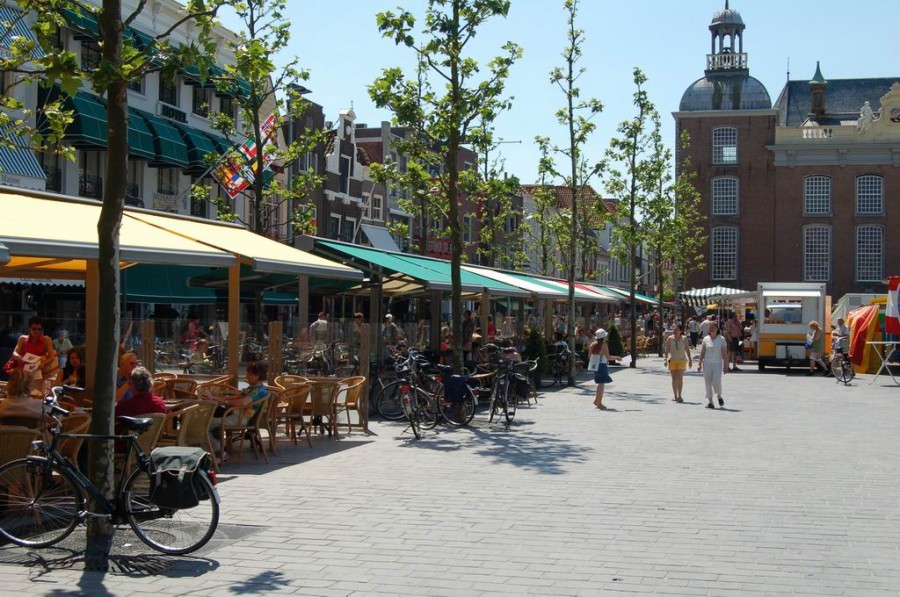A day in the city
Goes
Via the Zandkreek dam and the Delta road, one arrives in nearby Goes on Zuid-Beveland. Since the opening of the Westerschelde tunnel, it has been a busy town, a favourite with many Belgian visitors. The town's name refers to the geese, which feature in the town's coat of arms. Nor should you be surprised if traffic suddenly stops to give a row of geese the right of way when crossing.
As part of the 600th anniversary of the city of Goes, the Grote Markt was redesigned, but fortunately the Old Town Hall remained unchanged as a landmark building and is still regularly used for weddings. The ground floor of the striking building houses an old city inn with an indoor terrace.
The Historisch Museum De Bevelanden is a former orphanage and recently completely restored and furnished. If you are interested in a piece of history, a visit is definitely recommended. Special exhibitions are 'Blinken en Verzinken' (Blinking and Galvanising) about the history of prosperity and drowned villages. 'Zeeuw meisje' is about the development of regional costumes and their use in advertising.
The monumental Grote Kerk opposite is open to visitors at set times and there you can marvel at the grandeur of architecture from days gone by. Zeelandhallen always has something going on for young and old, and if you want to work on your handicap, you can do so on the golf course 'De Goese Golf'.
Middelburg
The capital of Zeeland is Middelburg and should definitely not be missed on the visit programme. The more than 1,000-year-old city has a rich history and, with 1,200 (!) monuments, has beautiful old streets and atmospheric alleys. Along the old canals are stately buildings and warehouses, dating back to the glory days of the VOC (United East India Company).
The centre of Middelburg was badly hit by bombings and inundations (deliberate flooding) in World War II. It is a miracle that everything has been restored to its original state and the badly damaged 15th-century town hall is now the jewel in the Netherlands' fifth monument city. And don't forget to go inside to take a look at the lobby and the civic hall.
The town hall is one of the finest examples of Flemish late Gothic and a beautiful scale model is on display at Miniature Walcheren. A large number of Zeeland's villages have been recreated here in 1:20 scale, giving a good overview of Zeeland in miniature. Children have fun in an indoor play castle, the fairy tale tunnel, on a little train and in a playground with radio-controlled boats.
Another highlight is the Abbey complex with the Lange Jan tower. The tower is over 90 metres high and after climbing 207 steps you have an unparalleled view over Walcheren. In clear weather, you can even see part of the surrounding islands. The Markt is the heart of Middelburg and the hub of several shopping streets. There are regular events here such as the jazz festival, the blues route, the mussel festivities and the folklore days.
Veere
Opposite Kamperland on Lake Veere is the pretty town of Veere. From Noord-Beveland, the town can be reached by ferry, passing close to the island of Haringvreter. Veere was very prosperous from the 14th to the 16th century and merchants from all corners of the world came here to trade. The Scots in particular left their mark here by building large residential and warehouses on the Kaai, where wool and madder were stored.
The Scottish houses De Struys and Het Lammetje have been preserved and now house the Museum Schotse Huizen, which tells the fascinating story of the Scottish connection. The distinctive Campveerse Toren stands at the entrance to the harbour on Noorderhoofd. Originally part of the defences around the town, it was also used as a fire beacon for shipping. From the 16th century, the building was expanded to include an inn, and there is still a great view of the Veerse Meer from the two large and beautiful halls. Famous guests have stayed here, such as William of Orange, who had the wedding meal served in the tower on the occasion of his marriage to Charlotte de Bourbon.
Zierikzee
The monument city of Zierikzee is worth a visit. Via the Zeeland Bridge, it is the first place on Schouwen-Duiveland, which one encounters and from afar the St Lievens Monstertoren or popularly known as Dikke toren is clearly visible. It is the most striking monument of Zierikzee, which was one of the richest cities in the Netherlands in the Golden Age. The tower was supposed to be the tallest in the country, but due to lack of money, only one-eighth of it came to fruition. The view from the tower is breathtaking and one can see quite a bit of Zeeland on a clear day.
The old city gate gives access to the cosy city centre, where one finds numerous shops, terraces and restaurants. Every Thursday there is a market on the Havenplein, which together with the Havenpark and the Oude Haven is the centre of many activities. Many events take place here in July and August, including the famous horse market.
The New Harbour, the gateway to the Eastern Scheldt is used for local fishing and there is also a marina here. The terraces on the Nieuwe Haven are a great place to relax and have a nice view of a coming and going of ships of all shapes and sizes. You can explore the town's rich history in several museums, including the Town Hall Museum on Meelmarkt. The monumental building was the town hall of the former municipality of Zierikzee until 1996.




